begin quote from:
48 mins ago - Thousands of people were ordered to evacuate some of the priciest enclaves on Earth. In a week of fires up and down the state, the Getty was ...
Top stories
Web results
ADVERTISEMENT
Getty fire spreads in elite enclaves, a celebrity-studded spectacle of L.A.’s inherent dangers
OCT. 29, 2019
7 AM
The cantilevered palaces of Los Angeles’ elite were under siege. “Apocalypse bags” were packed. LeBron James fled with his family and couldn’t find a hotel room. News copters filmed the fire copters, as drivers on the 405 Freeway sailed through the fiery vortex and lived to Instagram it.
The Getty fire broke out along the freeway by Getty Center Drive after 1:30 a.m. Monday and blew up to more than 600 acres under Santa Ana winds, destroying eight homes and damaging five in Brentwood. Thousands of people were ordered to evacuate some of the priciest enclaves on Earth.
In a week of fires up and down the state, the Getty was not the biggest or most destructive. But fires that break out in Sepulveda Pass and roar up to the rich and famous — the last one, two years ago, went to the other side of the 405 in Bel-Air — have a way of becoming more than natural phenomenons. They become shared experiences that unfold in wall-to-wall TV coverage and dramatic social media images that speak to the city’s character and inherent dangers.
Chad Ebert, 43, evacuated his Brentwood home and watched the flames in the predawn dark.
Wood exploded, flaming debris lofted into the wind.
“It’s very surreal,” Ebert said “It’s like a scene out of a movie.”
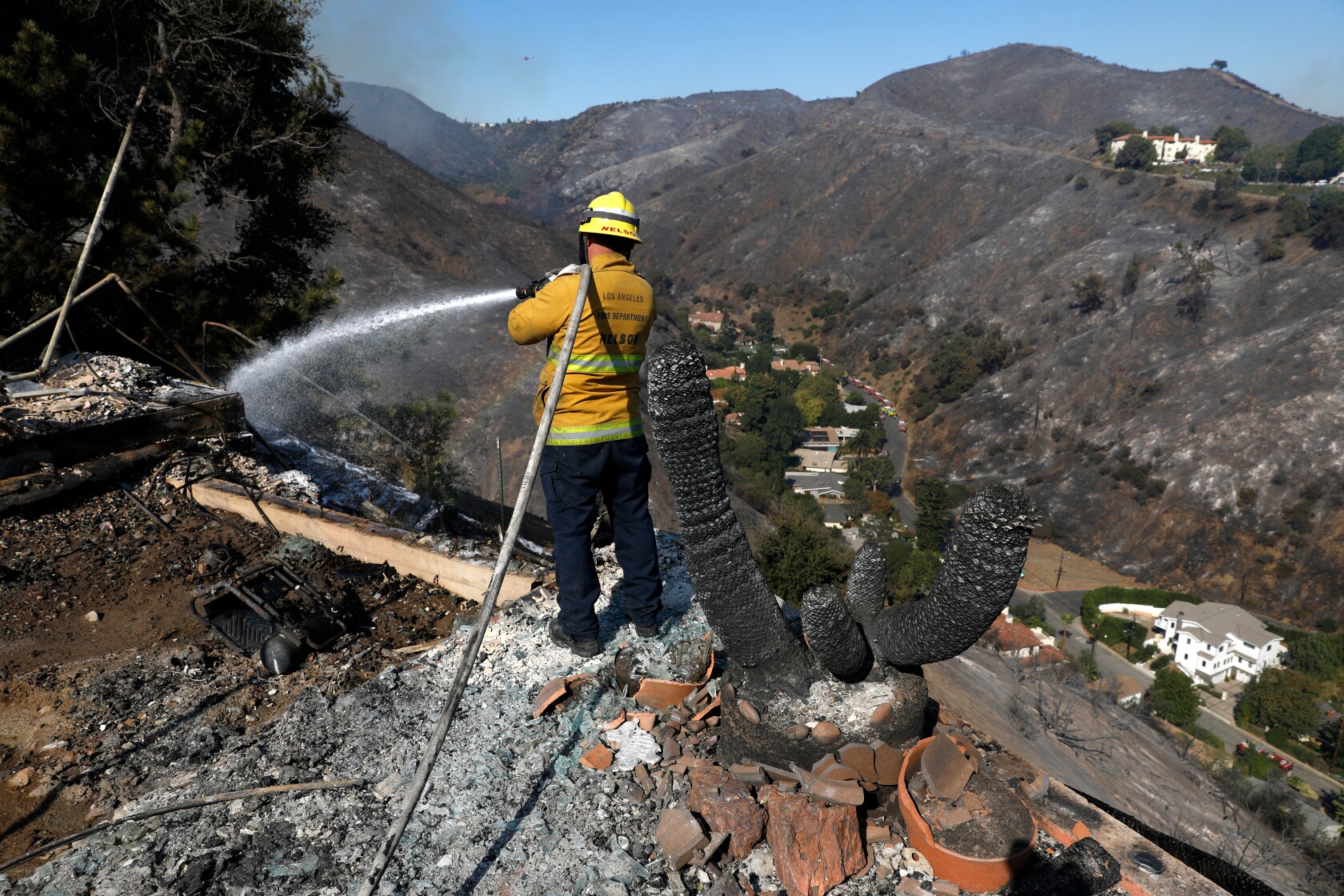
1/22
A firefighter sprays down hot spots on a home along the 12000 block of Sky Lane Monday in Los Angeles, Calif. (Gary Coronado/Los Angeles Times)
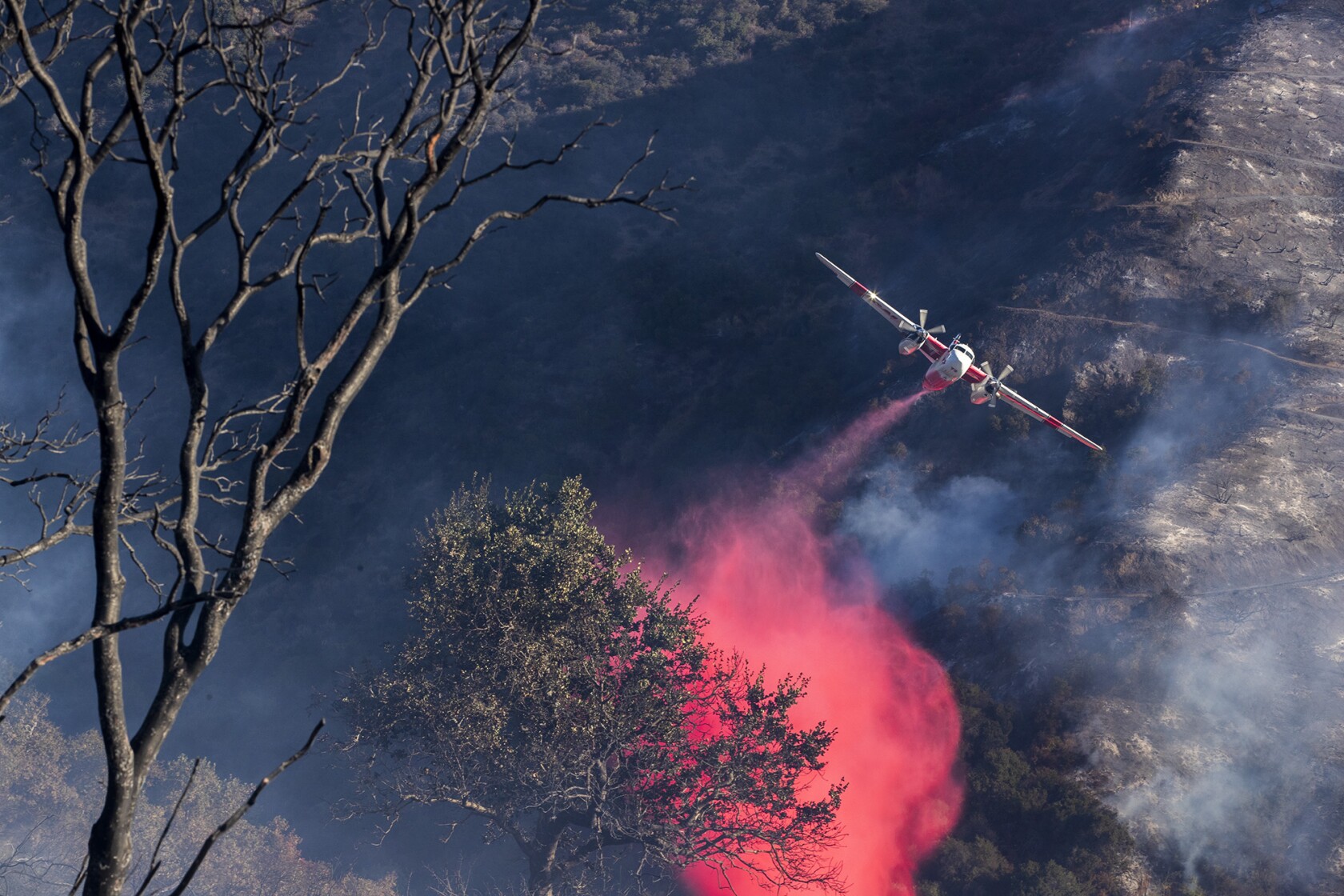
2/22
A firefighting aircraft drops fire retardant on the Getty fire in Mandeville Canyon near the Brentwood Heights neighborhood of Los Angeles. (Brian van der Brug/Los Angeles Times)
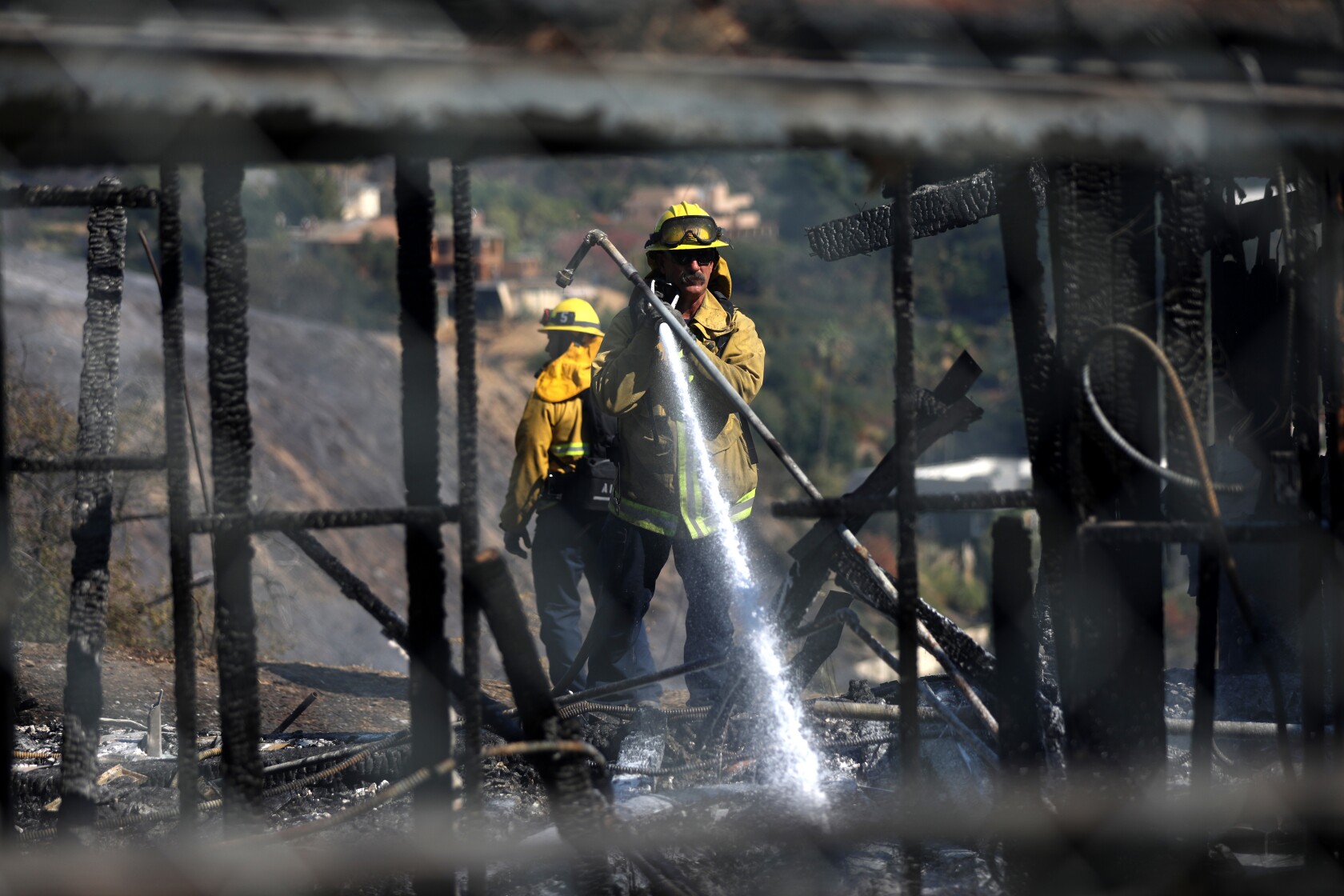
3/22
Los Angeles firefighters mop up after a home was destroyed by the Getty fire along Tigertail Rd. in Los Angeles. (Gary Coronado/Los Angeles Times)

4/22
From left, Betsy Landis, 90 and her neighbor Nola Hyland, 79, who both evacuated from their homes at the end of Mandeville Canyon, talk with Rochelle Linnetz, inside the Westwood Recreation Center on Sepulveda Blvd. that was turned into an evacuation center. (Mel Melcon / Los Angeles Times)

5/22
The Getty fire broke out shortly before 2 a.m. Monday along the 405 Freeway near the Getty Center and spread to the south and west, threatening thousands of homes in Brentwood and other Westside hillside communities. (KTLA)
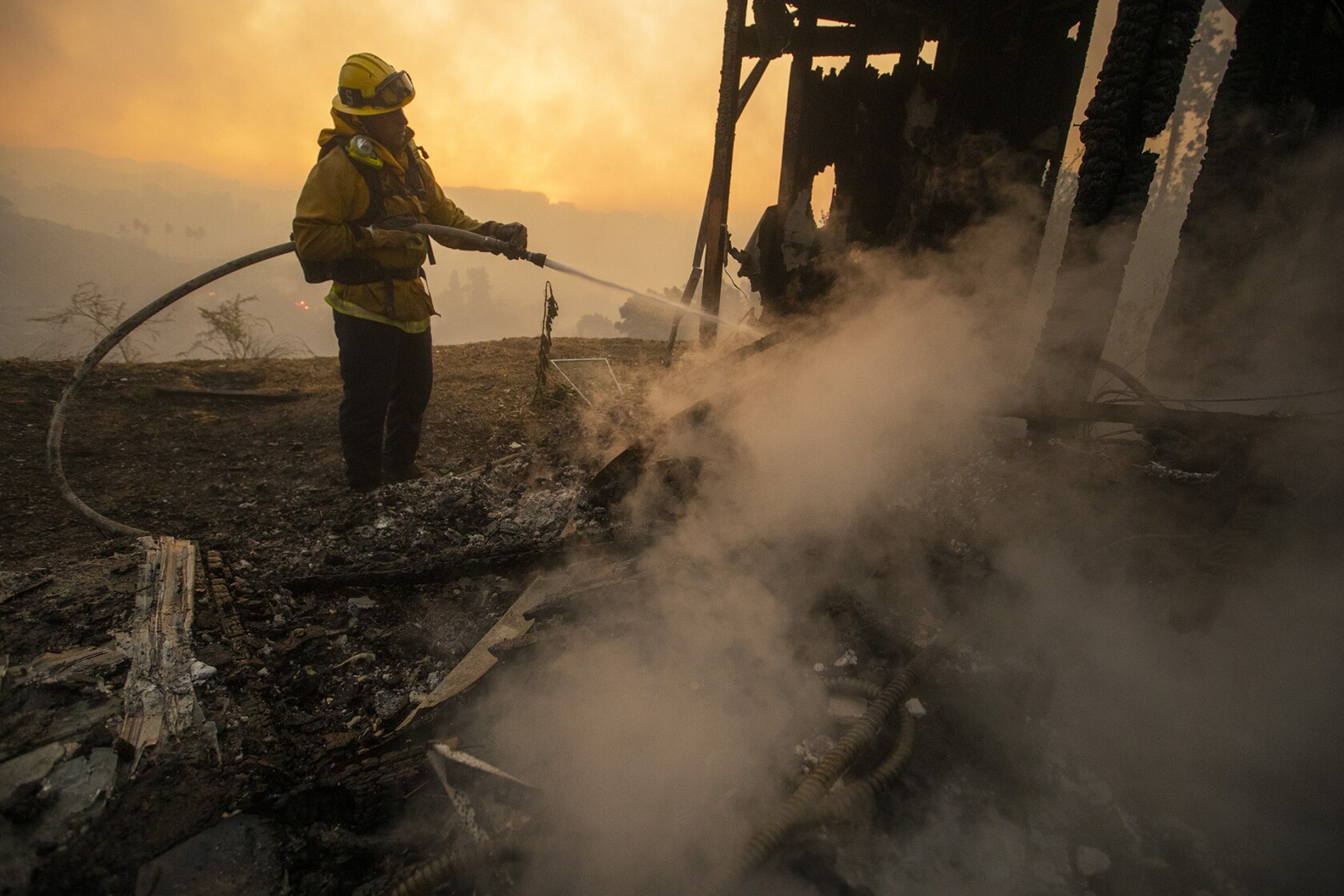
6/22
An L.A. City firefighter keeps down flames at a burned home in the 1100 block of Tigertail Road in the Brentwood Heights neighborhood of Los Angeles. (Brian van der Brug/Los Angeles Times)
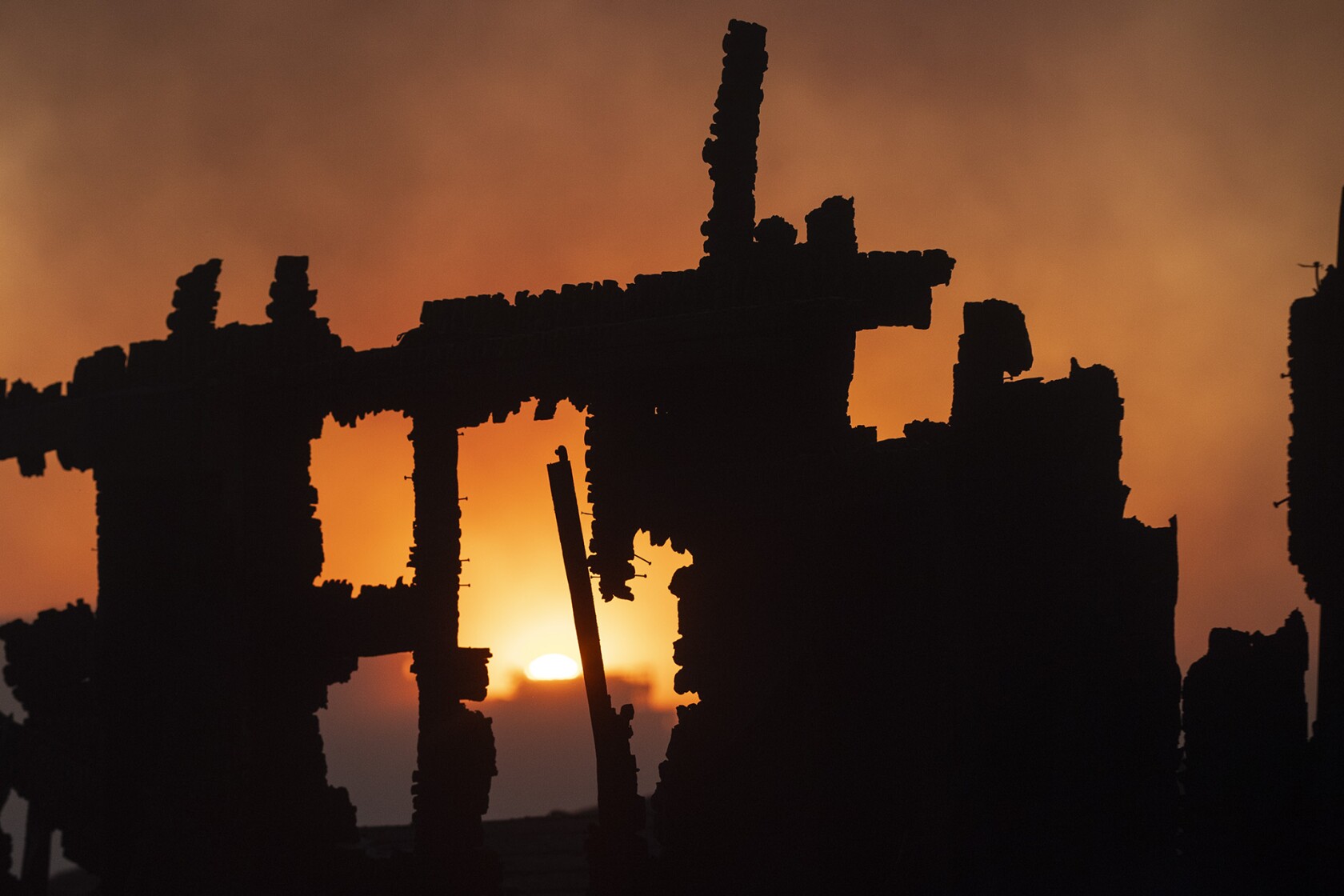
7/22
The sun rises over smoke filled canyons above the Getty museum and a burned home on Tigertail Rd. as the Getty fire burns in Los Angeles, Calif. (Brian van der Brug/Los Angeles Times)

8/22
Alex Holbrook, a student EMT at UCLA, talks with Sylvia Snow, 95 inside the Westwood Recreation Center on Sepulveda Blvd. that was turned into an evacuation center. (Mel Melcon / Los Angeles Times)

9/22
The sun rises over a smoke-filled canyon above the Getty museum as the Getty fire burns in Los Angeles. (Brian van der Brug/Los Angeles Times)

10/22
L.A. Fire Department arson team conducts an investigation near a utility pole of a possible area of origin of the Getty fire along the 1700 block of N Sepulveda Blvd. (Gary Coronado/Los Angeles Times)

11/22
Barn manager Stephanie Nagler, leads a horse named, Howie Doin, to a horse trailer while helping to evacuate around 120 horses from the Sullivan Canyon Equastrian Community, located near the intersection of Rivera Ranch Rd. and Sunset Blvd. in Brentwood. (Mel Melcon / Los Angeles Times)

12/22
A helicopter makes a drop on the Getty fire, which was threatening thousands of homes in Brentwood and other hillside communities on the west side of Los Angeles Monday morning. (Gray Coronado/Los Angeles Times)

13/22
Aerial view of homes shrouded in smoke from the Getty fire. (KTLA)

14/22
Barn manager Stephanie Nagler, left, holds a rabbit named Chi Chi,while helping to evacuate animals, mostly horses, from the Sullivan Canyon Equestrian Community, located near the intersection of Riviera Ranch Rd. and Sunset Blvd. in Brentwood. (Los Angeles Times)

15/22
Firefighters work the Getty fire as it burns homes along Tigertail Rd. in the Brentwood Heights neighborhood of Los Angeles. (Brian van der Brug/Los Angeles Times)

16/22
Firefighters work heavy brush along Sepulveda Blvd. in the Sepulveda Pass as the Getty fire burns in Los Angeles. (Brian van der Brug/Los Angeles Times)
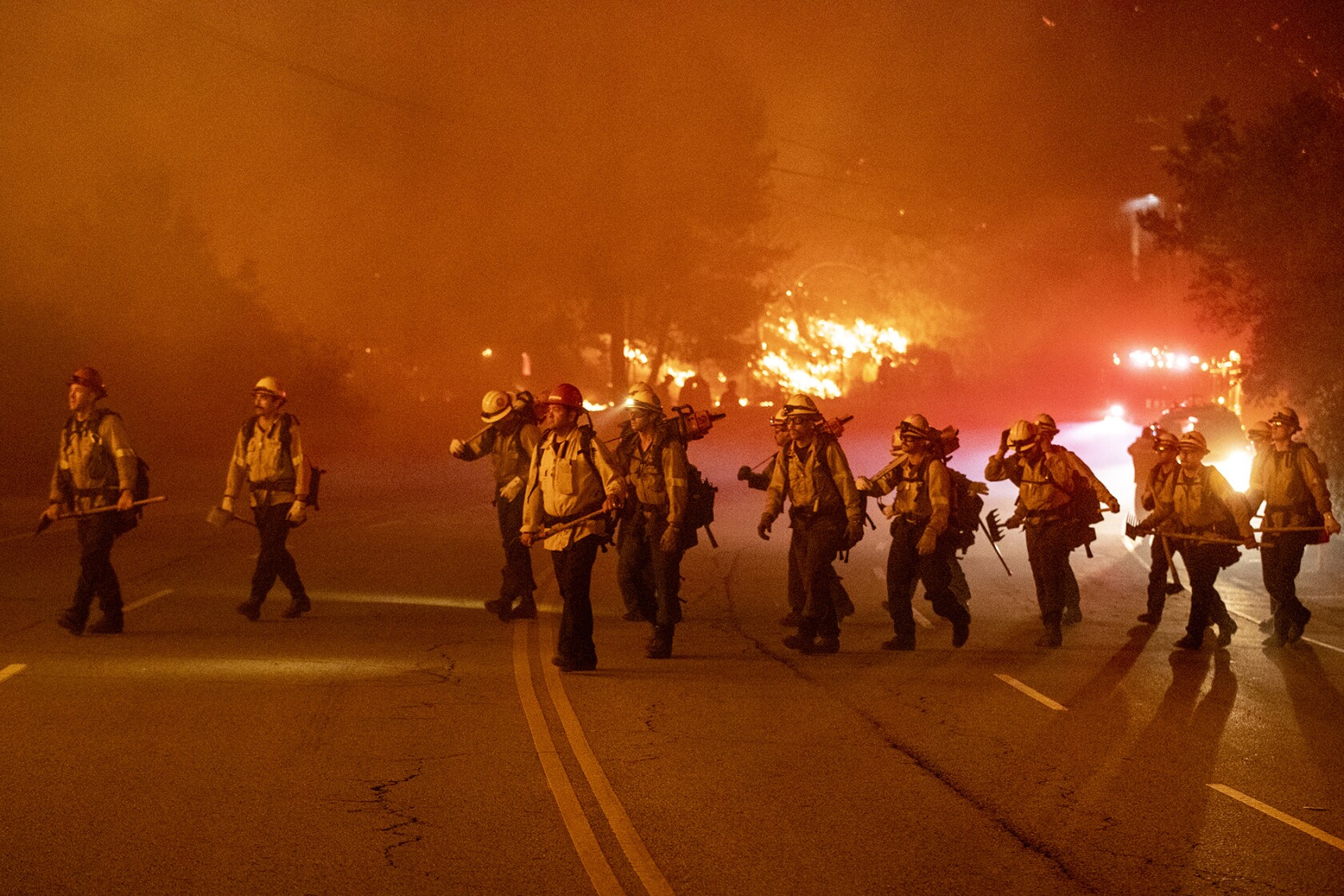
17/22
Firefighters head out for brush work along Sepulveda Blvd. in the Sepulveda Pass as the Getty fire as it burns in Los Angeles. (Brian van der Brug/Los Angeles Times)

18/22
Firefighters work in heavy brush along Sepulveda Blvd. in the Sepulveda Pass as the Getty fire burns in Los Angeles. (Brian van der Brug/Los Angeles Times)

19/22
Firefighters try to save a home on Tigertail Road during the Getty fire in Los Angeles on Monday morning. (Christian Monterrosa/Associated Press)

20/22
A man walks past a burning home during the Getty fire in Los Angeles on Monday morning. (Christian Monterrosa/Associated Press)

21/22
A firefighter watches flames approach the Mandeville Canyon neighborhood during the Getty fire on Monday morning. (Christian Monterrosa/Associated Press)

22/22
Firefighters try to save a home from the Getty fire on Tigertail Road in Los Angeles on Monday morning. (Christian Monterrosa/Associated Press)
The Times is offering coverage of the Getty fire for free today. Please consider a subscription to support our journalism.
Diana Rodriguez, a second-year business major at Mount Saint Mary’s University, just above the Getty Center, was studying for her Principles of Management class when the lights flickered out for about a minute at 1:30 a.m. Monday. Five minutes later, she smelled smoke.
Then, around 2:30 a.m., resident assistants banged on the door of Rodriguez’s dorm. The students needed to gather their things and evacuate.
Rodriguez grabbed her laptop, phone, camera and chargers, stuffed her backpack with snacks and water, and left her dorm in pajamas. The sky was blood red: “Really, really red and orange — pretty, but a little freaky, too,” she recalled.
Ashes floated in the air. Her eyes stung from the smoke.
They put on masks and followed a road down the mountainside. Some students griped about having to evacuate; others were laughing “either because they didn’t know what was happening or as a coping mechanism,” Rodriguez said. The students were picked up about halfway down the mountainside by ambulances, which took them to the school’s Doheny campus and an evacuation center in Westwood.
Winds were driving the flames south and west, deeper into Brentwood’s canyons, toward Pacific Palisades. The steepness of the canyons drew the flames up in monstrous lashes.
Rhonda Taylor woke around 3 a.m. to her phone ringing. Her throat was parched and her head hurt. She picked up an alert from L.A. County, telling her she needed to leave her Palisades home.
She already had what she calls her “apocalypse bag” in the car, but grabbed extra toiletries, toothbrushes, clothes and water. She put her Pomeranian, Bu, in his carrier, swaddled a painting of her two children in pillowcases and loaded the car. As she drove to an evacuation center in Westwood, through smoke thick like a deep fog, Taylor cried, thinking of all the things she hadn’t had the time or the space in her car to gather up.
Taylor said she’s grown weary of the dread of fire, and worries that one day she will need to leave her home behind for good.
She wonders if it is worth living, as she puts it, “on the edge of fear.”
When a neighbor banged on the door of Robert Lempert’s Palisades home at 3:30 a.m., the Rand Corp. researcher woke to news of a fire burning near the Getty Center and several “panicked messages” from his mother-in-law, who lives in a neighborhood under evacuation. Lempert and his wife loaded up their cars with “go bags,” had his mother-in-law come to their house and waited for the order to evacuate. As of 10 a.m., Lempert said they were “still in wait-and-see mode.”
Lempert, an expert on climate risk management, said there is a growing awareness in his Westside neighborhood that these large-scale fires aren’t anomalous. He and his neighbors have taken steps to mitigate a fire’s ability to blow through their streets, chiefly by removing dry brush that can become kindling for firebrands, which he described as “a wind-driven sea of matches.”
”The Getty blaze, and a smaller one in the Palisades last week, are vivid demonstrations of this ‘new normal,’” Lempert said.
“It’s one thing to look at the risk maps and show them to your family,” he said. “It’s another to get a knock on your door at 3 in the morning.”
James, the Lakers superstar who has two homes in Brentwood, got that knock. He tweeted just before 4 a.m.
“Man these LA [fires] aren’t no joke,” James wrote. “Had to emergency evacuate my house and I’ve been driving around with my family trying to get rooms. No luck so far!”
Former Gov. Arnold Schwarzenegger also tweeted that he evacuated, and urged others to do the same.
But it’s not all glitterati who live and work in these hills.
Ramon Ramos, 67, parked his Chevy pickup, left his lawnmower and tools in back and walked along Kenter Avenue, stopping to glance up as an LAFD helicopter flew over him. He walked over and wheeled trash cans to the side of the street.“I have eight houses I have to stop at,” Ramos said.
On Mondays he would have been landscaping homes along Kenter and Hanley avenues. But today the Getty fire stopped him. “I’ve been waiting since 6 a.m. to get up here so that I can take out the trash cans,” Ramos said. “Is the trash going to get picked up tomorrow? I don’t even know.”
Ramos said he’s been tending gardens and clearing out brush in the area for more than a decade. He said none of his clients told him that they had been evacuated and that he didn’t have to come to work.
So he waited at a market, hoping that at some point he’d be allowed in. “Just want to get this done and go home,” he said. For a moment, Ramos stood at the top of some stairs staring at helicopters as they made water drops. He scratched his head and walked back down before driving to the next home.
In a region with such a wealth gap, there were, of course, different concerns. In another spot on Kenter, a 47-year-old Brentwood man who declined to give his name was on the phone, trying to figure out whether he should leave, and in which of his two luxury cars.
“I have to figure out what I’m going to do with my Ferrari,” he said.
By then the mandatory evacuation zone stretched from the 405 in the east to Temescal Canyon in the west, Mulholland Drive in the north to Sunset Boulevard in the south. CalTrans shut down southbound lanes of the freeway, causing a colossal traffic jam throughout the city. The Getty Center closed and UCLA canceled classes.
Fire pilots bombarded the hills with water, as hand crews cut breaks and engine crews protected homes. They know this terrain well, having fought back flames here in 2008 and on the other side of the canyon in Bel-Air in 2017.
With dry winds whistling through dense chaparral, they found themselves battling on multiple fronts. It was Los Angeles County firefighter Norman Queen’s job to keep a close eye on the fire behavior on the far side of a narrow canyon: A hand crew of 70 men and women were cutting lines across areas doused with water dropped by helicopters and tanker jets.
“Without those water drops, this fire would be completely out of control,” Queen said. “They’ve kept things cool enough to get boots on the ground.”
”The main concern now,” Queen added, “is to make sure there are no surprises — like fire erupting in the brush directly below those crews.”
Los Angeles Fire Department Chief Mark Curry stood on a cliff-edge patio bench in Brentwood, with panoramic views of the charred remains of some rarefied real estate.
“We’ve got a lot of work ahead of us,” said Curry, who arrived on the scene at 1:30 a.m. “We’re going to be here a long time.”
A challenge, he said, “has been saving older homes with wooden cantilevered patios built over dense brush.”
“Homes with concrete slabs,” he added, “we can save those.”
Times staff writers Louis Sahagun, Alex Wigglesworth, Jaclyn Cosgrove, Sonali Kohli and Rong-Gong Lin II contributed to this report.
NEWSLETTER
Get our Essential California newsletter
Brittny Mejia is a reporter on the Los Angeles Times’ Metro desk covering breaking news and stories on immigration and race. She is a military brat who calls Germany home and is a graduate of the University of Arizona.
Matthew Ormseth is a reporter for the Los Angeles Times. Before joining The Times in 2018, he covered city news and state politics at the Hartford Courant. He grew up in Arcadia and graduated from Cornell University.
Hannah Fry is a Metro reporter covering breaking news in California. She joined Times Community News in Orange County in 2013 where she covered education, Newport Beach city hall, crime and courts. She is a native of Orange County and attended Chapman University, where she was the editor-in-chief of the college newspaper, the Panther.
Joe Mozingo is a projects reporter for the Los Angeles Times.
Ruben Vives is a general assignment reporter for the Los Angeles Times. A native of Guatemala, he got his start in journalism by writing for The Times’ Homicide Report in 2007. He helped uncover the financial corruption in the city of Bell that led to criminal charges against eight city officials. The 2010 investigative series won the Pulitzer Prize for public service and other prestigious awards.
MORE FROM THE LOS ANGELES TIMES


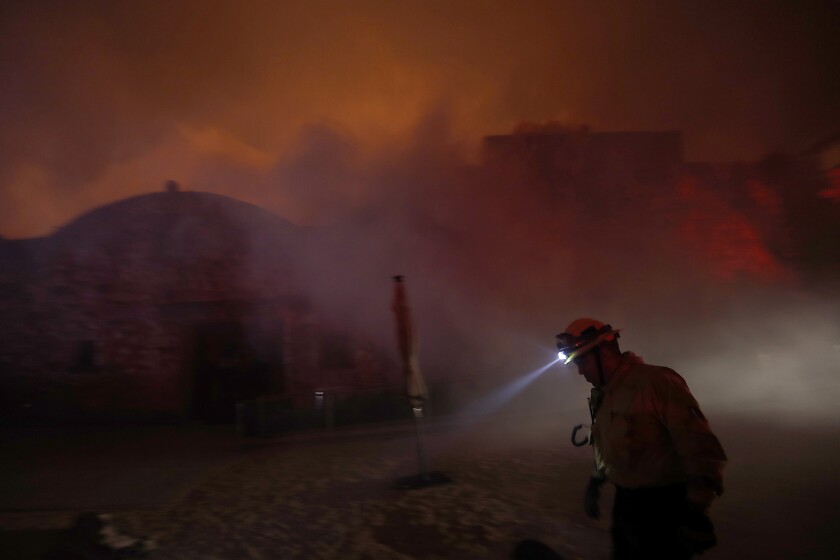
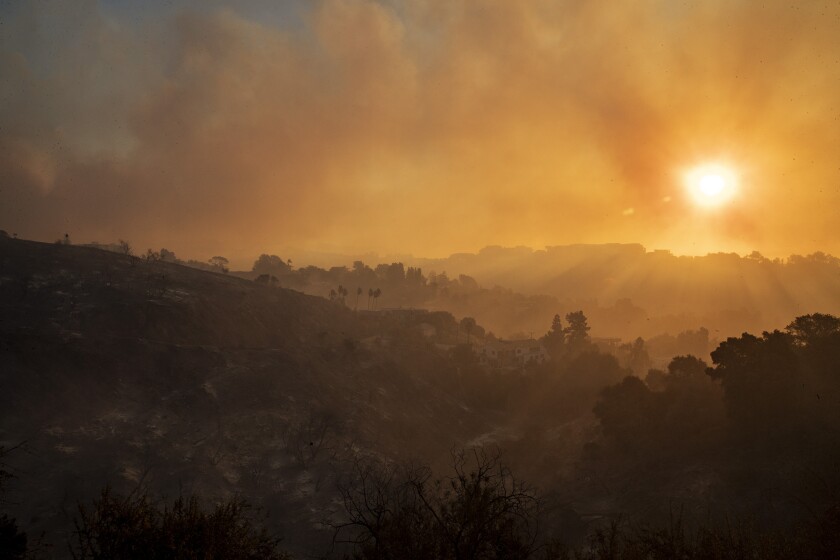





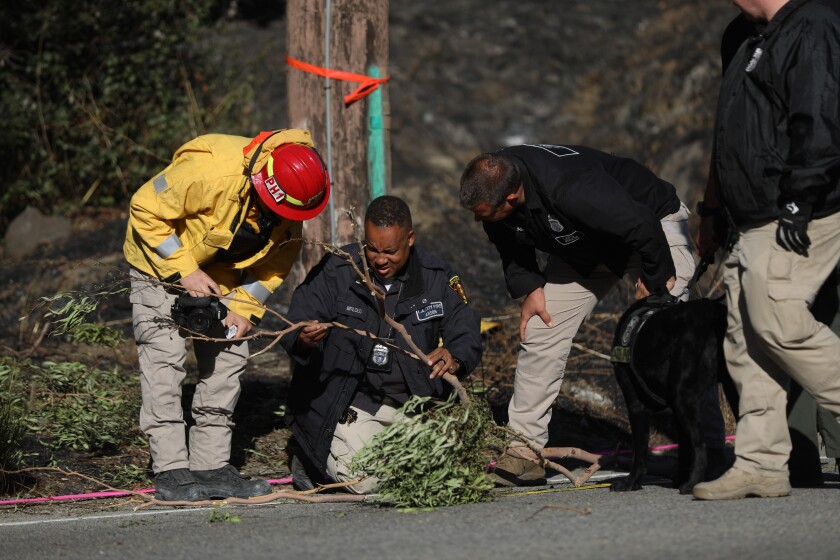
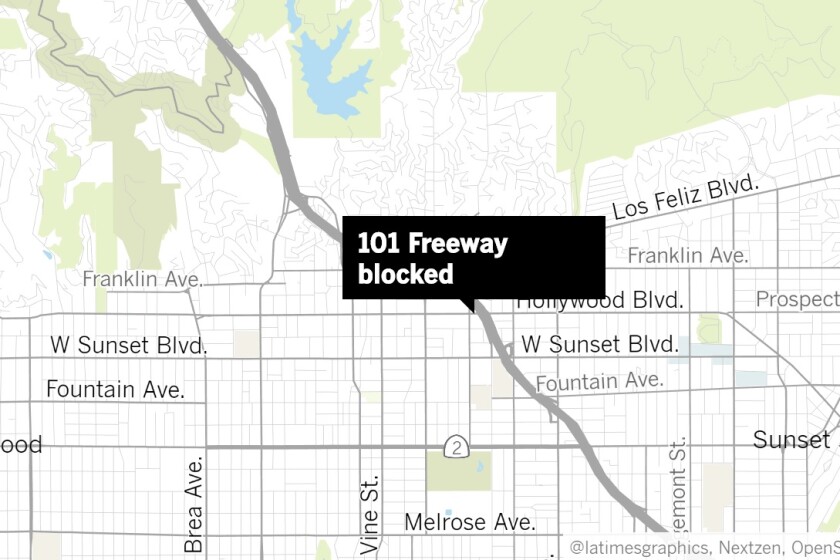
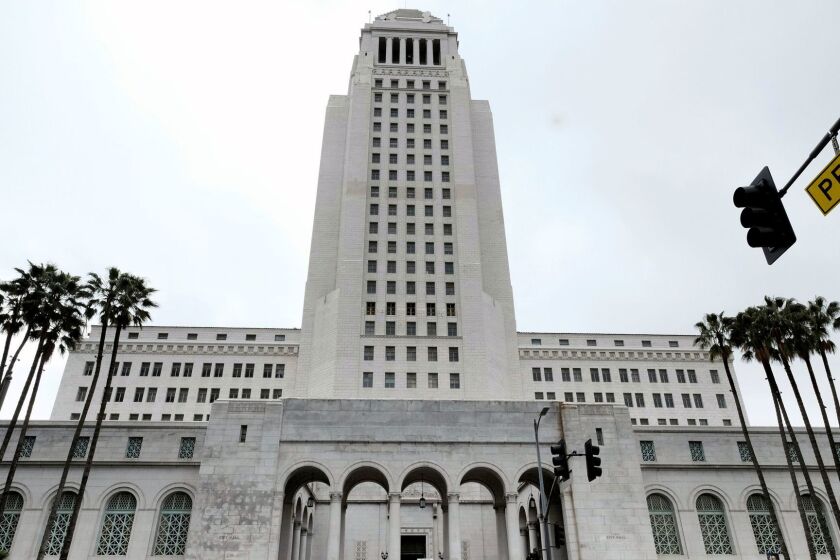
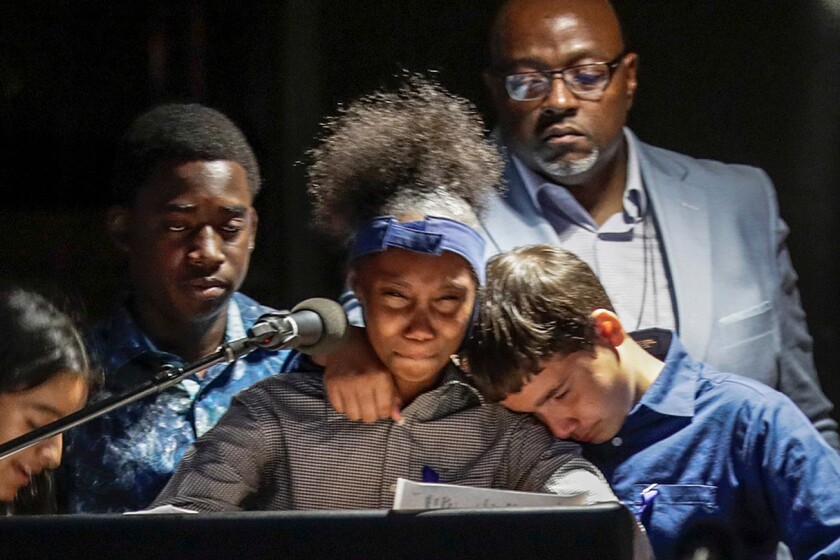
No comments:
Post a Comment